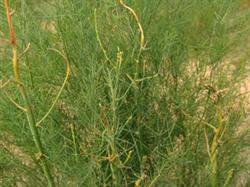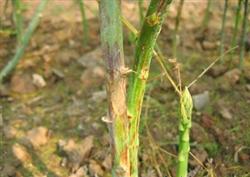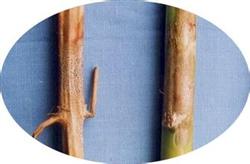Control techniques of asparagus diseases and insect pests

Asparagus stem blight and brown spot are the main diseases of asparagus. At present, there is no specific medicine for prevention and treatment. Practice has proved that the comprehensive disease prevention strategy based on agronomic measures supplemented by chemical control can achieve twice the result with half the effort. The specific methods are as follows: 1. Timely heart-picking to prevent lodging. The plant height of asparagus can reach more than 1.5 meters. If it is allowed to grow, it will seriously affect the ventilation and light transmission, and it is easy to lodge, and the field humidity is high and the disease is serious. When the plant is about 70 cm high, it should be coring at the right time, which is beneficial to concentrate nutrients and promote the growth of underground rhizomes. 2. Clean up the countryside. Clearing the countryside to reduce the source of infection is one of the effective methods to control stem blight. In February, the field stalks were cleaned completely, the diseased and residual branches and leaves were cleaned and burned centrally. After the bamboo shoots are collected in the first and middle of August, combined with returning to the soil and flat ridges, the residual piles and mother stems should be cleaned thoroughly, and the scale bud plates should be sterilized and sterilized. In the autumn stage, the diseased and residual branches and leaves in the field should be removed regularly, which can significantly reduce the occurrence of the disease. 3. Leave the mother stem to pick bamboo shoots and prolong the bamboo shoot picking period. In the new asparagus field in the second year after planting, only green asparagus should be harvested. Generally speaking, the young stems grown in the first and middle of April are left in the field as mother stems to support the roots. In the future, the tender stems will begin to be harvested. The harvest time is determined according to the quality of the autumn hair last year, and it can be harvested for 30 to 50 days. After the asparagus field entering the production period left 2-3 mother plants per hole in the first and middle of May, it can be harvested until the first and middle of August. This method not only increases the income of bamboo shoot farmers, but also avoids the peak of incidence caused by high temperature and humidity in July, reduces the frequency of medication and reduces the cost. 4. Rational fertilization. Increasing the application of organic fertilizer and phosphorus and potassium fertilizer and properly controlling the amount of nitrogen fertilizer can increase soil organic matter, loosen soil, promote the robust growth of asparagus stems and leaves, and improve disease resistance. 5. seize the favorable opportunity, rational use of drugs for prevention and treatment. In order to control stem blight, timely application should be applied in the critical period, and the old plants should be cut off by spraying liquid to the root plate before soil cultivation in spring. Spray immediately when leaving the mother stem to protect the young bamboo shoots from infection by the remaining diseased plants on the soil surface, and at the same time protect the mother stem from bacteria in the air, and coat the stem with a slightly thicker solution if necessary. The effective agents are 1500 times of 50% propofol wettable powder, 1000 times of 50% carbendazim wettable powder, 1000 times of 50% methyl thiophanate wettable powder, 50% of mixed sulfur suspension, 2% of Nongkang 120 water, 2000 times of Lubao 1, 50% carbendazim ultrafine wettable powder, 25% carbendazim water, 64% poison alum wettable powder. Shigao 1000 times liquid + 75% chlorothalonil 600x liquid spray. Pay attention to reasonable mixing or rotation of drugs, and the efficacy can be improved by adding 0.1% washing powder or 0.3% neutral soap or Tween 20 or other adhesives or spreading agents. During the growing period, the disease was prevented and treated once every 5-14 days, 3-4 times in a row, and the number of times was increased appropriately in case of rain, and the spray was made up in time after rain. In particular, the serious disease areas should grasp the young and tender stage which is easy to be infected and prevent and cure in time. Although the disease resistance of bamboo shoots is gradually enhanced for more than 40 days, spray protection should be carried out before soil cultivation or 2-3 days after harvest, and spraying should be stopped 7 days before bamboo shoots are picked. The control of brown spot should be started at the early stage of the disease. the medicament can be selected as 500x solution of 50% dimethrin wettable powder, 600x liquid of 70% methyl thiophanate wettable powder, 1500 times liquid of 6% carbendazim wettable powder, 1500 times liquid of carbendazim wettable powder, 140x solution of copper water agent, 500x solution of 50% copper succinate wettable powder, 47% carbendazim wettable powder solution. According to the disease, the disease was prevented and treated once every 10 days, for a total of 2 times. The main pests are Spodoptera litura, Spodoptera exigua, Helicoverpa armigera, ground tiger and so on. Nocturnal moths can be sprayed with 1000 dimethoate, 1000 times of dimethoate EC for aphid control, and trichlorfon bait for underground pests.
- Prev

Comprehensive prevention and control of asparagus diseases and insect pests
In the prevention and control of diseases and insect pests, scientific control measures should be adopted, pollution-free control technology should be vigorously promoted, and pesticides with high toxicity and high residues should be banned, so as to not only effectively control the harm of diseases and insect pests, but also make the pesticide residues in the products do not exceed the standard. In the prevention and control, take "prevention first, comprehensive prevention and control" measures, timely early prevention. (1) Agriculture.
- Next

Harm and control of asparagus diseases and insect pests
In recent years, with the continuous expansion of asparagus planting area, the damage degree of asparagus disease has become more and more serious, which has caused a lot of losses to the majority of bamboo shoot farmers. Asparagus diseases mainly include: stem blight, root rot, brown spot, stem blight, shoot blight and so on. The common diseases and control measures in the growth process of asparagus are introduced as follows: 1.
Related
- Where is it suitable to grow horseradish in China? it is expected to see the middle altitude horseradish in Alishan.
- How to prevent tomato virus disease reasonably? (Control methods included)
- Many people like to plant towel gourd on the balcony. What are the main points of this method and management?
- What crops can chili peppers be mixed with?
- Fertilization techniques and matters needing attention in Tomato
- What are the grafting techniques for peach seedlings in spring?
- Harm and control methods of root swelling disease of Chinese cabbage
- What are the pests of sweet potatoes? How to prevent and cure it?
- Symptoms, causes and Control methods of navel Rot in Tomato
- The cause of "Cucumber rotten bibcock" in Farmers' planting Cucumber and its Control Plan

